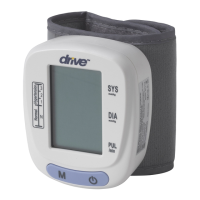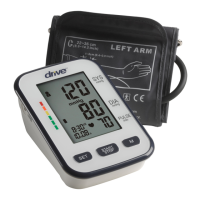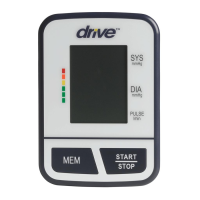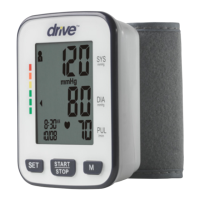Contents
Safety Not ice ............................................................... 02
Unit I llu st r at ion
Im por t ant Testing Guid elin es
Qu ick Sta r t ................................................................. 10
Blood P r essu r e I n for ma t ion
Blood P r essu r e Q&A
Ma in tena n ce
Specifica t ions
......................................................... 06
..................................... 09
Unit O p er a t ion
........................................................... 12
........................................ 26
................................................... 30
............................................................... 32
............................................................. 36
Wa r r a n t y .................................................................... 40
Bat t er y I n sta l
lat ion .................................................. 12
System Sett in gs ........................................................ 13
App lyin g T h e Wr ist Monitor .................................... 15
Testin g ..................................................................... 17
Power Off ................................................................. 21
M emor y C h eck ..........................
.............................. 22
M emor y Deletion ..................................................... 23
L ow Batter y I n d icat or ............................................. 24
Tr oub lesh ooting ...................................................... 25
Safety Notice
Safety NoticeSafety Notice
Owner ' s Manual
Wrist -typ e Fu lly Au t om atic
Blood Pressur e Mon itor
Model BP 2116
1
3
2
4
Wrist Type
Thank you for purchasing the B P 2116 Blood Pressure Monitor.
The unit has been constructed using reliable circuitry and
durable materials. Used properly, this unit will provide years
of satisfactory use.
7.To avoid any possibility of accidental strangulation, keep this
unit away from children and do not drape tubing around your
neck.
8.Ensure that children do not use the instrument unsupervised;
some parts are small enough to be swallowed.
9.Some may get a skin irritation from the cuff taking frequent
readings over the course of the day, but this irritation typicall
y
goes away on its own after the monitor is removed.
The device is intended for use by individuals 12 years and older
to measure the systolic and diastolic blood pressure and pulse
rate. All values can be read out in one LCD DISPLAY.
Blood pressure measurement determined with this device are
equivalent to those obtained by a trained observer using the
cuff/ stethoscope auscultation method, within the limits
prescribed by the American National Standard (ANSI/AAMI
Sp10) for electronic sphygmomanometers.
Pr ecau t ions to En su r e Safe, Relia ble Op er ation
1. Do not drop the unit. Protect it from sudden ja
r
s or shocks.
2. Do not insert foreign objects into any openings.
3. Do not attempt to disassemble the unit.
4. Do not crush the pressure cuff.
o
5. If the unit has been stored at temperatures below 0 C, leave it
in a warm place for about 15 minutes before using it.
Otherwise, the cuff may not inflate properly.
6. Do not store the unit in direct sunlight, high humidity or dust.
Document No.
Version: REV03.02.22.16
Important Instructions Before Use
1. Do not confuse self-monitoring with self-diagnosis.
Blood pressure measurements should only be interpreted by a
health professional who is fam
iliar with your medical hist
ory.
2. Contact your physician if test results regularly indicate
abnormal readings.
3. If you are taking medication, consult with your physician to
determine the most appropriate time to measure your blood
pressure. NEVER change a prescribed medication without first
consulting with your physician.
4. Individuals with serious circulation problems may experience
discomfort. Consult your physician prior to use.
5. For persons with irregular or unstable circulation resulting
from diabetes, liver disease, arterio
sclerosis or other medical
conditions, there may be variations in blood pressure values
measured at the wrist versus at the upper arm. Monitoring the
trends in your blood pressure taken at either the arm or the wrist
is nevertheless useful and important.
7. People sufferi
ng from arrhythmias such as atrial or ventricular
premature beats or atrial fibrillation only use this blood pressure
monitor in consultation with your doctor. In certain cases
oscillometric measurement method can produce incorrect
readings.
8. Too frequent measurements can cause injury to the patient due to
blood flo
w interference.
9. The cuff should not be applied over a wound as this can cause
further injury.
10.DO NO T attach the cuff to a limb being used for IV infusions or
any other intravascular access, therapy or an arterio-venous (A-
V) shunt. The cuf
f inflation can temporarily block blood flow,
potentially causing harm to the patient.
11.The cuff should not be placed on the arm on the side of a
mastectomy. In the case of a double mastectomy use the side of
the least dominant arm.
12. Pressurization of the cuff can temporarily cause loss of function
Contact Information
The lay operator or lay responsible or ganization should contact
the manufacturer or the representative of manufacturer.
-for assistance,if needed,in setting up,using or maintaining
the product,or
-to report unexpected operation or events.
Drive Medical
99 Seaview Blvd
Port Washington, NY 11050
Toll-Free 877-224-0946
www.drivemedical.com
6. People suffering from vascular constriction, liver disorders or
diabetes, people with cardiac pacemakers or a weak pulse, and
women who are pregnant should consult their physician before
measuring their blood pressure themselves. Different values
may be obtained due to their condition.
of simultaneously used monitoring equipment on the same limb.
13.A compressed or kinked connection hose may cause continuous
cuff pressure resulting in blood flow interference and potentially
harmful injury to the patient.
14.Check that operation of the unit d
oes not result in prolonged
impairment of the circulation of the patient.




